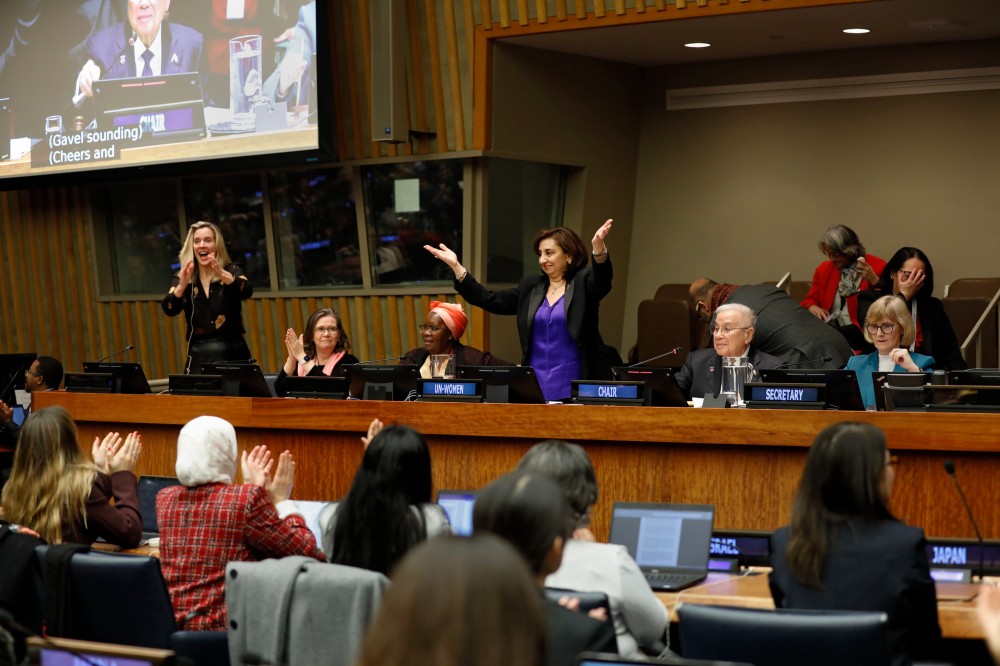Advancing gender equality and eye health: Reflections on UN Commission on the Status of Women 68 and beyond | Bond
Advancing gender equality and eye health: Reflections on UN Commission on the Status of Women 68 and beyond Bond


The 68th session of the UN Commission for the Status of Women (CSW68)

The 68th session of the UN Commission for the Status of Women (CSW68), convened last month in New York City, serving as a pivotal moment for UN Member States to unite and commit to robust measures in combating women’s and girls’ poverty worldwide.
Priority theme: Accelerating the achievement of gender equality and the empowerment of all women and girls
With the priority theme being ‘Accelerating the achievement of gender equality and the empowerment of all women and girls by addressing poverty and strengthening institutions and financing with a gender perspective’, the Agreed Conclusions, presented by the UN Secretary General at the close of the two weeks, underscored a sobering reality:
Globally, 10.3 per cent of women live in extreme poverty today and progress towards ending poverty needs to be 26 times faster to achieve the Sustainable Development Goals by 2030.
The impact of poverty on women and girls
The Agreed Conclusions further elucidated the profound impact of poverty on women and girls, describing them as “shock absorbers” in times of crisis. Consequently, it emphasised the urgent need to bolster resources to address this issue and strive for more positive and equitable outcomes for women and girls.
The Fred Hollows Foundation’s role in addressing poverty and vision loss
This was my second time attending the CSW as the Head of Gender and Advocacy and Engagement at The Fred Hollows Foundation. The Fred Hollows Foundation is a global leader in international development, working in over 25 countries to combat avoidable blindness and vision loss. Our goal is to transform lives through innovative eye health solutions, and we believe that a stronger systems-change approach at the national and global level will generate the broad and sustained transformation required to benefit people living with preventable vision loss.
The resolution on eye health
In July 2021, the United Nations General Assembly unanimously adopted the first ever resolution on eye health. Of the 1.1 billion people living with vision impairment that could have been prevented or treated, 55% are women. The resolution elevated eye health as a critical social, development and economic issue, and called upon member states and other stakeholders to eliminate barriers and discrimination against women and girls in accessing support and eye health services. There is no doubt that addressing eye health inequalities can help close the gender gap and ensure women are able to exercise their rights in all areas of society.
Challenges faced by the UN Commission for the Status of Women
While the conclusion of the CSW68 did culminate in robust commitments by UN Member States to address the pervasive issue of women’s and girls’ poverty, it would be remiss not to mention that its sessions were often overshadowed by the looming financial constraints currently faced by the United Nations. Throughout the two weeks, this tension was palpable, particularly when negotiations were forced to promptly stop at 6pm each night, with lights and heating also turned off when sessions were not on. This time limitation raised concerns, including whether CSOs had the access they were due and even to the extent of whether agreed conclusions could be reached. Despite these barriers, however, the Agreed Conclusions were published.
The role of Universal Health Coverage (UHC) in combating poverty
Our parallel event hosted on the fringe of the CSW sought to bring attention to the central role achieving UHC for women has in combating poverty and driving economic empowerment for growth for women and girls.
Looking ahead: The 30th anniversary of the Beijing Platform for Action
Looking ahead, attention is now focused on the 30th anniversary of the adoption of the Beijing Platform for Action, with the 69th session of the Commission on the Status of Women (CSW69) scheduled for March 2025 in New York. As the global community continues its efforts towards gender equality, the outcomes of CSW68 serve as a critical step in addressing women’s and girls’ poverty worldwide.
SDGs, Targets, and Indicators
| SDGs | Targets | Indicators |
|---|---|---|
| SDG 1: No Poverty | 1.1 By 2030, eradicate extreme poverty for all people everywhere | Indicator not mentioned in the article |
| SDG 5: Gender Equality | 5.1 End all forms of discrimination against all women and girls everywhere | Indicator not mentioned in the article |
| SDG 8: Decent Work and Economic Growth | 8.5 By 2030, achieve full and productive employment and decent work for all women and men, including for young people and persons with disabilities, and equal pay for work of equal value | Indicator not mentioned in the article |
| SDG 10: Reduced Inequalities | 10.1 By 2030, progressively achieve and sustain income growth of the bottom 40 per cent of the population at a rate higher than the national average | Indicator not mentioned in the article |
| SDG 3: Good Health and Well-being | 3.8 Achieve universal health coverage, including financial risk protection, access to quality essential health-care services, and access to safe, effective, quality, and affordable essential medicines and vaccines for all | Indicator not mentioned in the article |
1. Which SDGs are addressed or connected to the issues highlighted in the article?
- SDG 1: No Poverty
- SDG 5: Gender Equality
- SDG 8: Decent Work and Economic Growth
- SDG 10: Reduced Inequalities
- SDG 3: Good Health and Well-being
The article discusses the issues of women’s and girls’ poverty, gender equality, and access to healthcare services. These issues are directly connected to the Sustainable Development Goals (SDGs) mentioned above.
2. What specific targets under those SDGs can be identified based on the article’s content?
- Target 1.1: By 2030, eradicate extreme poverty for all people everywhere
- Target 5.1: End all forms of discrimination against all women and girls everywhere
- Target 8.5: By 2030, achieve full and productive employment and decent work for all women and men, including for young people and persons with disabilities, and equal pay for work of equal value
- Target 10.1: By 2030, progressively achieve and sustain income growth of the bottom 40 per cent of the population at a rate higher than the national average
- Target 3.8: Achieve universal health coverage, including financial risk protection, access to quality essential health-care services, and access to safe, effective, quality, and affordable essential medicines and vaccines for all
The article highlights the need to address extreme poverty, discrimination against women and girls, employment and decent work, income growth for the bottom 40 percent of the population, and access to healthcare services.
3. Are there any indicators mentioned or implied in the article that can be used to measure progress towards the identified targets?
No specific indicators are mentioned or implied in the article that can be used to measure progress towards the identified targets. The article provides general information about the issues but does not provide specific data or indicators.
Behold! This splendid article springs forth from the wellspring of knowledge, shaped by a wondrous proprietary AI technology that delved into a vast ocean of data, illuminating the path towards the Sustainable Development Goals. Remember that all rights are reserved by SDG Investors LLC, empowering us to champion progress together.
Source: bond.org.uk

Join us, as fellow seekers of change, on a transformative journey at https://sdgtalks.ai/welcome, where you can become a member and actively contribute to shaping a brighter future.







